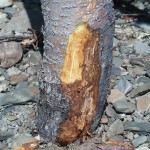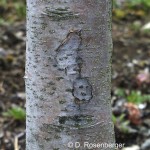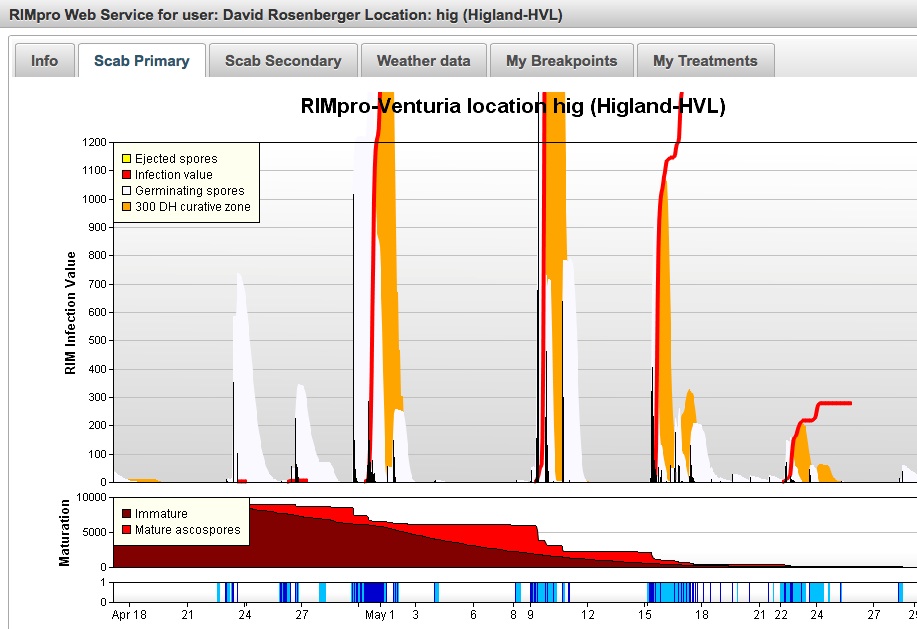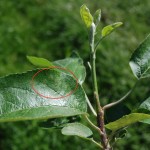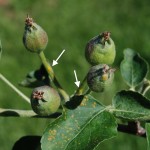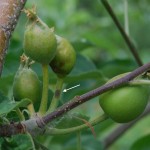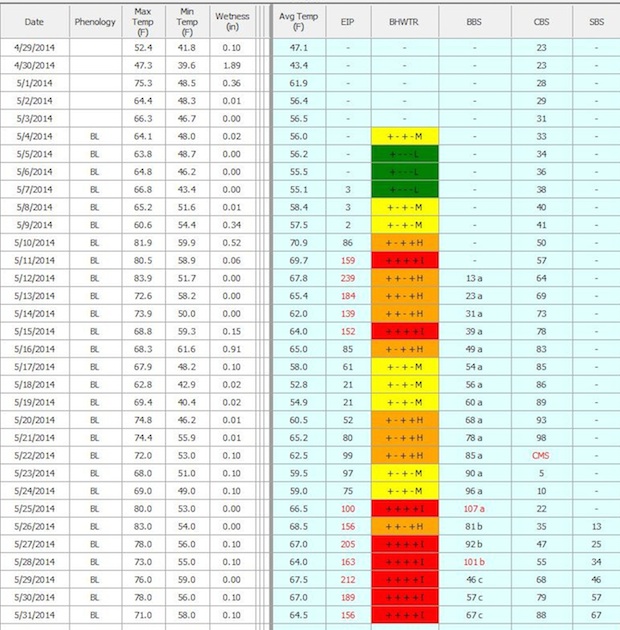We found the first mature apple scab ascospores this afternoon, 7 March 2016. It appears that we may need to be ready for a really fast start to the scab season in 2016.
Dan Donahue, extension educator for the Eastern NY Commercial Horticulture Program, picked up leaves yesterday from several abandoned orchards north of Red Hook, NY, which is about 30 miles north of the Hudson Valley Lab. Because last year was very dry during late summer, we had some difficulty finding good scab lesions and scab pseudothecia in his samples. However, I finally located a fat scab pseudothecium, the black globular structure embedded in leaf tissue that contains the asci and apple scab ascospores.
When I checked a squash mount of this pseudothecium under the microscope, mature ascospores were immediately evident within some of the asci (Fig. 1). Each ascus contains eight ascospores. More importantly, as I watched, some of the asci began discharging their spores, a process that involves the sudden rupture of the end of the ascal tube with spores rapidly streaming out through that opening. For microscopic observations, the squash mounts are prepared in water and the pseudothecium is “squashed” between the slide and a glass cover slip. Thus, the asci are in water and the ascospores are therefore ejected into the thin film of water between the slide and cover slip. When the tip of the ascus ruptures, there is a sudden and dramatic movement of the spores as they rapidly stream out of the ascus.
Earlier today, we had run a “tower shoot” in which wet leaves were placed into a spore tower and a vacuum was applied to the base of the tower so that any ascospores released would be drawn down through the tower and captured on greased slides. We did not find any released ascospores in our tower shoot, but that sample of leaves came from a Golden Delicious orchard and the leaves seemed to have very little over-wintering scab. The leaves in which I found active ascospores were from an unknown cultivar in a different block. We will be testing leaves from yet another block just north of the lab tomorrow morning in an attempt to confirm the presence of mature ascospores. However, conditions that prevailed for many of the past 60 days (daytime temperatures well above freezing with enough moisture to keep leaf litter wet) would favor early maturation of ascospores, so I am not too surprised that we found mature spores today.
What does the detection of discharging spores mean from a grower perspective? First of all, so far as I know there is no green tissue yet on any apple trees in the Hudson Valley, and scab is not a threat until we have both green tissue and a Mill’s infection period. However, the Accuweather forecast for Highland, NY, for the next three days (Tues, Wed, Thurs) is calling for daytime highs of 65, 78, and 70 F before things cool down with predicted rains after Thursday of this week. Night time lows for those same days are predicted as 41, 52, and 48 F. Thus, both apple buds and spore maturity will move rapidly during the next three days, although I am uncertain whether trees will reach green-tip before the predicted rains for Thursday.
The real value of today’s report on mature ascospores is that this detection of mature spores is the “biofix” that we need to initiate the RIMpro scab program. Since the leaves we checked today were picked up yesterday and left in a cool truck over night, I will be entering March 6th (the collection date) as my biofix date for mature spores. Hereafter, assuming we can confirm mature spores from another orchard tomorrow, the RIMpro program will use temperature and rainfall records to predict scab risk. I’ll post more about those predictions tomorrow, but remember that there is no scab risk in the orchard until we can see green tissue on the trees.

Figure 1. Apple scab ascospores observed 7 March 2016 from a leaf sample collected on 6 March.


